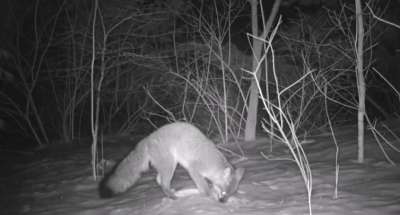Editor's note: This blog is by our friend Janet Pesaturo, a writer, educator, and CyberTracker certified wildlife tracker. Check out her wildlife tracking programs here.
Foxes are sometimes said to be part dog and part cat, and of the two species that roam the Northeast, the gray fox is more cat-like than the red. The gray’s semi-retractable claws and rotating forelimbs make it a good climber. Its roundish tracks, which often lack claw marks, are more apt to be confused with house cat tracks than red fox tracks. The gray fox also looks somewhat cat-like in its body posture and behavior.
With the help of a trail camera, I had the opportunity to compare the two foxes to each other, and to compare them both to a wild feline and a larger wild canine. The camera was mounted near a deer carcass and set to take a burst of three photos each time it was triggered. The carcass attracted, in this order, a gray fox, a bobcat, a pair of coyotes, and a red fox. To create the video, I spliced sequential photos with a duration of a quarter of a second per photo. That makes it possible to roughly compare the speed of movement of the animals.
Watch the movie and notice the physical differences between the two fox species. Only the slender red fox wears black stockings on its long legs. The stouter gray fox has shorter, gray legs and a more cat-like body shape and stance. I’ve found that body posture helps me distinguish between the two species when all I get is a quick glimpse.
It’s interesting to compare the behavior of the different animal species in the video. The gray fox and the bobcat both work slowly and deliberately, pausing frequently to scan the surrounds. The two coyotes appear slightly more anxious and watchful, and more aware of the camera. But the hyperkinetic, nimble red fox nervously retreats after each quick bite or two.
Red foxes are among the fastest animals on the planet, clocking in at 45 mph for short sprints, compared to the gray fox’s 39 mph top speeds. What I don’t know is if the red fox is typically that jumpy, or if it feared the return of the larger predators, which it must have detected by scent. The gray fox’s relative calm and composure might have been due to the fact that it was the first to visit the carcass. What do you think? Feel free to share your thoughts or questions in a comment below.


